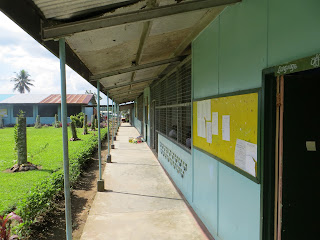Take a left out of Kokopo and you begin to wind your way up
into the hills of the Gazelle Peninsula, quite quickly the landscape changes
from a small coastal town to rural villages hidden amongst masses of vegetation,
roadside market stalls and a consistent flow of people going ‘walk about’ on
the roadside. After about 20 minutes you have climbed your way up onto a ridge
which looks over to the Baining Hills (See background picture of blog). The
view is stunning; on a clear day you get a 180 degree view of the valley and
the mountains stretching right up to the sea in the north. You slowly make your
way up to 4 Way Junction, so called because it is one of the only ones on East
New Britain, and after taking a left you descend down the other side of the
ridge and across the valley passing over Toli, Taulil and Baining land (3 main cultural
groups of ENB) until the sealed road ends and you begin the last few kilometres
down a bumpy dirt track to Gaulim Teachers College.
The view from our balcony
Gaulim from the air
Gaulim Teachers College (GTC) was built in the 1970s, and by
all accounts the infrastructure has not been updated since. Apart from a new
(2003) ‘state of the art’ ICT room the facilities and buildings are quite poor
and in need of some major renovations. The current administration seem to be
putting some money into this with new roofs being added to some of the
classrooms and a new generator installed which offers power during the frequent
and often long lasting black outs. Our college is compact, with a classroom
block (10), dining hall (mess) and chapel alongside the male and female
dormitories. It has a large sports field
and staff housing scattered around the outskirts of the grounds. Gaulim is run
by the United Church, originally it was the Methodists who acquired the land
and set up the college, later to be taken on by the United Church (we think
this is an Anglican/Methodist mix).
Some may say Gaulim is run down, and I guess it is, I did
fall through the floor boards in my first week on the job! However, there is
something quite charming about it that gives it a very pleasant character. It
could be that it is situated among a local community which gives it a very
‘homely’ type feel, it might also be how isolated it is, making it very relaxed
and peaceful.
The students at Gaulim are amazing; they come from all over
the country and from all walks of life, with some coming straight out of high
school, and others mature students. For many of the student teachers, following
this path was not a choice they made independently with many being sent and
paid for by their community, meaning the pressure to succeed is massive. Others
have got scholarships and the rest are self-funded. Overall we have found that
the students put so much effort into their work and take immense pride in their
achievements as well as the college life. The effort they put into some of
their projects in incredible, they had an art display last weekend and every
classroom had been decked out in decorations and set up as market stalls
holding all sorts of art work as well as traditional artefacts, it really was a
spectacular sight.
Some of the students' displays at their art show
Sports oval
Opening of the new boys pit toilet
The musical talent at the college is also fantastic.
Students are often practising for church services and the songs they sing are
wonderfully harmonised, and sung both in English and Tok Pisin. Several of the
students play guitar or a band instrument, and everyone seems to get involved
in the beautiful singing here. Our house is surrounded by the sounds of guitars
strumming and groups singing, day and night. On a recent bus journey with
students from Milne Bay we were treated to traditional songs of the province by
an all-male chorus, as we wound up the hilly roads at sunset. It was magical.
Most of the staff live on campus, as we now also do, and
there is a small local market which offers mainly bananas, betel nut, and local
‘packed lunches’ wrapped in banana leaves. Early (4am) on a Saturday morning
the market grows and you can get a great variety of fresh fruit and vegetables
there. Living on campus gives us a great
sense of community, the local people, students, lecturers and their families
are all really friendly and always looking out for us. The other day I started
digging a hole for our rubbish burning and by the end I had more people wanting
to help me than I did shovels, and I eventually wasn’t allowed to do any of the
labour. We have been given a patch of land to start a vegetable garden on, no
doubt we will have plenty of helpers and advice coming our way.
Living at a teachers’ college is giving us a great insight
into an education community here in PNG as well as learning about the local
community. We feel very privileged in our placement and the opportunities we
are having.





















